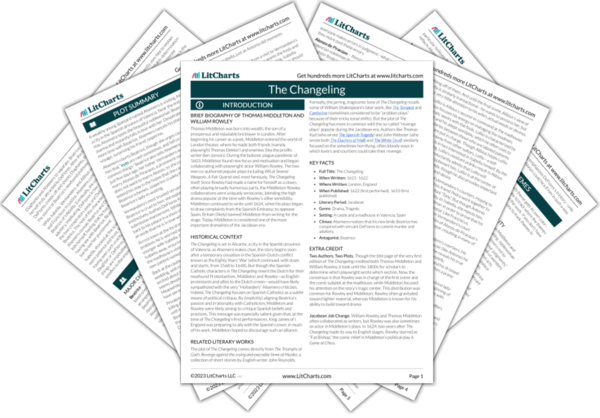Throughout The Changeling, eyes symbolize the fact that appearances can be misleading. Many of the characters use physical appearance as a gauge of personality: Alsemero, for example, thinks that the beautiful shape of Beatrice’s face signals her virginity (“modesty’s shrine is set in yonder forehead”), while Lollio perceives Antonio to be a fool simply because of his messy clothes. Yet the play repeatedly demonstrates that eyesight is not always trustworthy—as Beatrice herself puts it, “eyes are rash sometimes, and tell us wonders of common things. Indeed, Beatrice’s “modest” appearance hides the fact that she’s a murderer and an adulterer, and Antonio is not a fool but a scheming, noble knave. On the one hand, then, The Changeling makes clear that “rash” eyesight is not a reliable marker of reality, as exterior semblances do not always match interior truths. But on the other hand, the play embraces misperception as an inevitable part of life. When Vermandero mourns his daughter’s betrayal, Alsemero comforts him by using the symbolism of eyes to suggest that perception is always changing: “as [the tears] go from your eye,” he tells Vermandero, “let [them] go from your heart.” Ultimately, then, The Changeling shows that eyes can hurt and mislead—but, in giving people a way to cry and move on, eyes can also be healing.
Eyes Quotes in The Changeling
BEATRICE: Be better advised, sir:
Our eyes are sentinels unto our judgments
And should give certain judgment what they see;
But they are rash sometimes, and tell us wonders
Of common things, which when our judgments find,
They can then check the eyes, and call them blind.
LOLLIO: Yes, sir, for every part has his hour: we wake at six and look about us, that’s eye-hour; at seven we should pray, that's knee-hour; at eight walk, that's leg-hour; at nine gather flowers and pluck a rose, that's nose-hour; at ten we drink, that’s mouth-hour; at eleven lay about us for victuals, that’s hand-hour; at twelve go to dinner, that’s belly-hour.
BEATRICE: Methinks I love now with the eyes of judgment
And see the way to merit, clearly see it.
A true deserver like a diamond sparkles,
In darkness you may see him, that’s in absence,
Which is the greatest darkness falls on love;
Ye he is best discern’d then
With intellectual eyesight.












